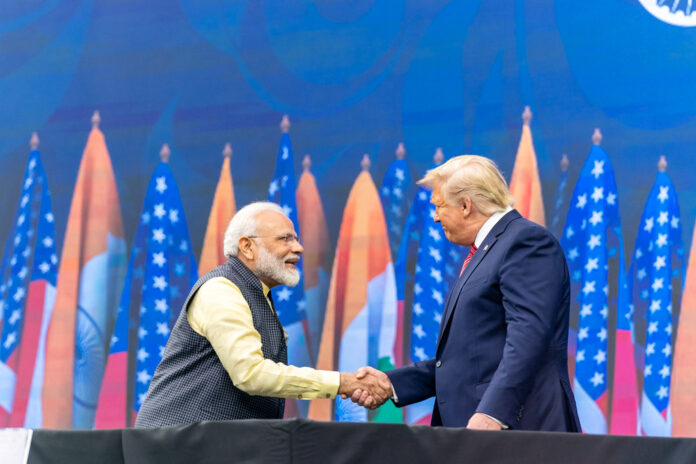Prime Minister Narendra Modi will visit the United States from February 12-13, as announced by Foreign Secretary Vikram Misri on Friday. During the visit, PM Modi will meet with US President Donald Trump. The announcement follows a recent statement from a White House official confirming that President Trump had extended an invitation to PM Modi for a meeting next week.
India, an important strategic partner of the United States in countering China, is eager to strengthen trade and defence ties with the U.S. and facilitate easier access to skilled worker visas for its citizens.
With Trump back in office, India-U.S. defence relations are expected to continue expanding, though with a focus that may differ from the recent past. Trump’s “America First” approach to foreign policy is likely to impact the nature and depth of the bilateral defence relationship. While India remains a strategic partner in the Indo-Pacific region, several factors will shape the future trajectory of this partnership.
Defence Minister Rajnath Singh had his first telephonic conversation with the newly appointed U.S. Secretary of Defence, Pete Hegseth, on February 6, 2025. During the discussion, both leaders reportedly agreed to collaborate on drafting a comprehensive framework for defence cooperation between India and the United States for the period 2025-2035. The conversation took place ahead of Prime Minister Narendra Modi’s upcoming visit to Washington next week.
According to an official statement, the two Ministers reviewed the broad spectrum of India-U.S. defence cooperation across multiple domains, including land, air, maritime, and space. They are said to have expressed appreciation for the ongoing expansion of the bilateral defence partnership and reaffirmed their commitment to strengthening ties further. Rajnath Singh also congratulated Pete Hegseth on his recent confirmation as U.S. Secretary of Defence.
The two leaders agreed to focus on key areas such as technology cooperation, integrating defence industrial supply chains, enhancing military interoperability, and improving logistics and information sharing. Joint military exercises and defence innovation collaboration involving governments, start-ups, businesses, and academic institutions were also highlighted as priority areas.
Several significant defence deals between the two countries are reportedly under discussion. These include the co-production of Stryker infantry combat vehicles, the licensed manufacturing of General Electric F-414 jet engines in India, and addressing delays in the delivery of F-404 engines for the Light Combat Aircraft (LCA)-Mk1A, which have affected its induction timeline.
A U.S. readout on an earlier conversation between Prime Minister Modi and President Trump, following his re-election, mentioned that the President had stressed the importance of India increasing its procurement of American-made security equipment and working toward a more balanced bilateral trade relationship.
The Quad alliance (comprising the U.S., India, Japan, and Australia) will remain a key pillar in this strategy, with the U.S. likely to encourage deeper military cooperation, joint exercises, and interoperability of forces. Expectations include increased joint military exercises such as Malabar and Yudh Abhyas and strengthened maritime security cooperation to counter China’s assertiveness in the Indian Ocean.
Trump’s emphasis on boosting American defence exports is likely to translate into pressure on India to purchase more U.S.-made defence equipment. The conversation can shift from co-development and co-production toward more direct procurement deals.
There is strong potential for collaboration in high-tech areas such as artificial intelligence, unmanned systems, cybersecurity, and space-based defence. Trump’s administration will likely leverage this to deepen India-U.S. defence ties, especially through partnerships involving the private sector and start-ups.
There are opportunities in expanding the Defence Technology and Trade Initiative (DTTI), developing next-generation weapons, and collaborating on space-based surveillance systems. Hydrogen-based defence energy systems align well with India’s National Green Hydrogen Mission.
India’s push for Atmanirbhar Bharat (Self-Reliance) in defence manufacturing may create friction with the U.S., particularly if India insists on higher technology transfer and local production. Balancing self-reliance with U.S. strategic interests will be something to watch out for.
Co-production projects will face delays, while U.S. companies could seek more relaxed procurement rules in India. Supply chain integration for critical defence components will expand, reducing dependence on China.
While Trump and Modi have historically shared good personal chemistry, Trump’s transactional approach are likely to lead to tougher negotiations.
Issues like India’s purchase of the Russian S-400 missile defence system will definitely resurface, drawing potential U.S. sanctions under CAATSA (Countering America’s Adversaries Through Sanctions Act), unless waivers are granted. Renewed U.S. focus on the subcontinent’s defence ties with Russia, pressure to reduce its dependence on Russian hardware, and possible trade-offs between defence deals and broader trade negotiations remain risks.
India-U.S. defence relations under Trump’s second term will be a complex mix of opportunities and challenges. While strategic interests in the Indo-Pacific and shared security goals will drive cooperation, Trump’s transactional approach and focus on American defence exports may lead to more intense negotiations. Balancing the former’s self-reliance ambitions with U.S. demands will require deft diplomacy and a strong focus on mutual benefit.
The success of this relationship will depend on how well both sides align their strategic priorities while addressing differences in defence trade, technology transfer, and supply chain integration. If managed well, it could result in a significantly expanded partnership that benefits both nations’ security and economic interests.



